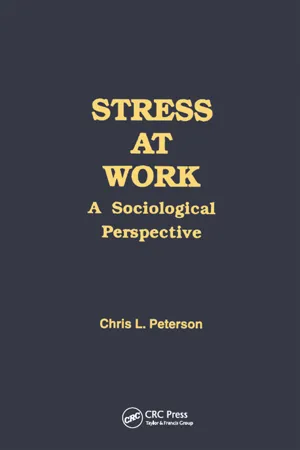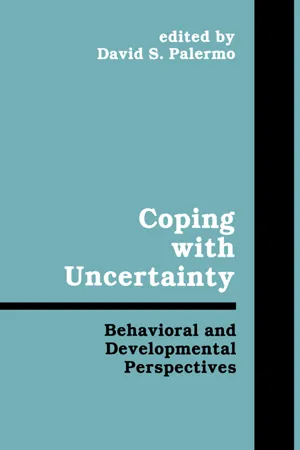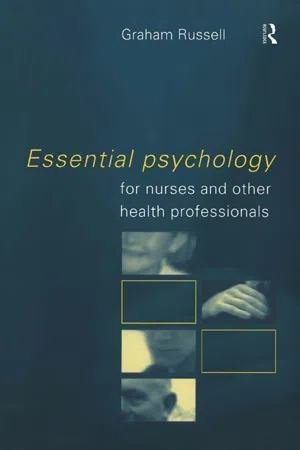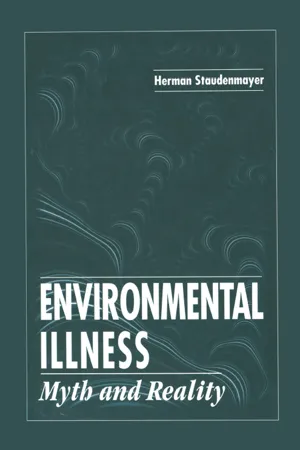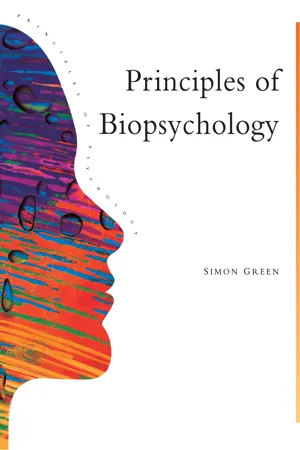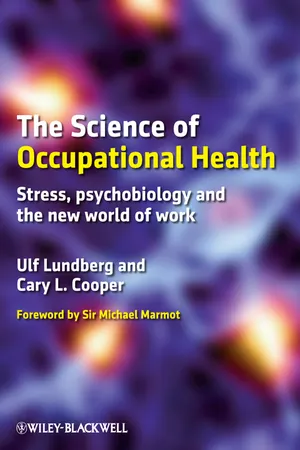Psychology
Physiology of Stress
The physiology of stress refers to the body's response to stress, involving the activation of the sympathetic nervous system and the release of stress hormones such as cortisol and adrenaline. This physiological response can lead to increased heart rate, elevated blood pressure, and heightened alertness, preparing the body to deal with perceived threats or challenges.
Written by Perlego with AI-assistance
Related key terms
8 Key excerpts on "Physiology of Stress"
- eBook - ePub
Stress at Work
A Sociological Perspective
- Chris Peterson(Author)
- 2018(Publication Date)
- Routledge(Publisher)
Chapter 3 , has moved closest to treating stress in a context of social, cultural, economic, and political processes. Sociology focuses on longer term processes in which a number of forces act to produce a biophysiological response.THE STRESS RESPONSEDespite differences in research orientation, there is general agreement on the type of physiological reaction in the stress response. Levi (17 ) outlines the physiology of the stress process. The autonomic nervous system and the endocrine glands are the most important defenses of the body. He argues, following Selye’s work, that the most immediate response in adaptation to stress is through the sympathetic and parasympathetic divisions of the autonomic nervous system. This results in the body’s functional adjustment. Levi describes the next stage as (17 , p. 7 ):an increased production of the stress hormone adrenalin from the adrenal medulla in response to signals from the sympathetic nervous system. This stepped up adrenalin production, together with signals from the hypothalamus (the anterior part of the brain stem) stimulates the pituitary to increase its hormone production. The pituitary hormones regulate the production of hormones by other endocrine glands, and these hormones in turn participate in various ways in the body’s defence and adaptation reactions.According to Levi, ACTH is an essential hormone in this process: it controls a number of other hormones, the most important being cortisol.Selye identified an important problem in understanding the physiological response in stress. He found that no one agent could be called the first mediator of the stress response; he discounted adrenalin, noradrenaline, acetylcholine, and histamine. He argued that the first mediator may be an emotional reaction to unpleasant stimuli, thus triggering a physiological reaction.The physiological reaction involves a stressor, activated through two pathways, one through the sympathetic nervous system to the adrenal medulla and the other a hormonal response. This occurs through the pituitary gland, and the secreted ACTH activates the adrenal cortex, as described below. While the adrenal medulla and cortex belong to the same gland, their reactions are entirely separate. Through the hypothalamus, the autonomic nervous system, the part of the nervous system that operates without conscious control, is activated. Thisleads to stimulation of the adrenal medulla, producing secretions of adrenalin and noradrenaline. The initial reaction of the autonomic nervous system is the stimulation of the nerve endings, producing an immediate response; this is later followed by hormone secretion by the adrenal medulla. The result is an increased heart rate, dilation of the pupils, increased blood pressure, and increased perspiration. An increased awareness in response to the stressor results in restricted blood flow to parts of the body other than those being affected. - eBook - ePub
The Handbook of Stress
Neuropsychological Effects on the Brain
- Cheryl D. Conrad(Author)
- 2011(Publication Date)
- Wiley-Blackwell(Publisher)
Although stress is often perceived in a negative light, it is actually a very useful and highly adaptive response. The body understands the importance of stress, but also the potential damage that it can cause, and is therefore equipped with central and peripheral systems that both promote and suppress it (Sapolsky et al., 2000). Activation of these systems (i.e., the stress response) represents an evolutionarily conserved ability of an organism to deal with circumstances that require vigilance, arousal, and/or action (Neese and Young, 2000). In addition to facilitating the perception and processing of stress, the stress response is also designed to restore balance. To this end, the various neurotransmitters, peptides, and hormones that are released in response to stress serve a protective function for an organism (McEwen, 2000b). Importantly, these neurochemical mediators stimulate tissues to respond in an appropriate and adaptive manner to the stressful circumstance at hand (McEwen and Seeman, 1999). The physiological component of the stress response can be further modified by psychological processes, such as coping and appraisal, which can aide in (or potentially hinder) the restoration of balance.The experience of too much stress over time can have adverse consequences on health and behavior, but never experiencing any stress would result in inactivity, boredom, and an inability to adequately respond to internal/external demands. For instance, stress can be useful to motivate and prepare organisms to deal with situations such as writing a research paper or escaping from a predator. To appreciate the function of stress in a given situation, it is important to consider the stressor. There are a number of internal and external causes of stress, and these are generally characterized into two categories. Systemic (also referred to as physiological - eBook - ePub
Coping With Uncertainty
Behavioral and Developmental Perspectives
- Davis S. Palermo(Author)
- 2014(Publication Date)
- Psychology Press(Publisher)
2 The Physiology of Stress and Behavioral Development Elizabeth J. Susman The Pennsylvania State University Editha D. Nottelmann National Institute of Mental Health Lorah D. Dorn The Pennsylvania State University Philip W. Gold National Institute of Mental Health George P. Chrousos National Institute of Child Health and Human Development S tress (a state of threatened homeostasis) has been implicated in the onset of physical illness and psychiatric disorders in individuals of all age groups. Recent research in several disciplines, including developmental psychology, endocrinology, and psychiatry, has begun to examine the processes linking environmental stressors (threats against homeostasis), the physiology of the stress response and physical illness, psychiatric disorders, and behavioral development in general. In this chapter, we examine first the physiological responses to stress as a mechanism whereby environmental stressors may affect the course of behavioral development throughout the life span. Next, we discuss individual differences in reactivity to stressors. The physiological processes involved in our formulations of stress reactivity are primarily those involving the interactions between hormones of adrenal and gonadal origin. Finally, we examine stressors in three domains in which stress-related physiological changes may lead to alterations in behavioral development: (a) social and emotional stressors during adolescence; (b) physical stressors, with exercise as a paradigm; and (c) stressors associated with affective disorders - Graham Russell(Author)
- 2002(Publication Date)
- Routledge(Publisher)
Part fourPsycho-physiology: The relationship between mind and body• Psycho-physiological reactions to acute and chronic stress• Personality type and disease• Psychological perspectives on painChapter 12
Psycho-physiological reactions to acute and chronic stressLearning outcomesBy the end of this chapter you should be able to:• Outline the general adaptation syndrome.• Describe how stress may affect the body's immune response.There is now a considerable body of evidence showing that psychological factors can exert a direct effect on the body’s physiological systems. In this section, we will focus on three specific topics that are of direct relevance to nursing practice. The first examines the effects that stress can have on the body and the immune system. The second explores the role that personality type may play in the aetiology of major diseases, such as coronary heart disease and cancer, and the third focuses on the role that psychological factors play in mediating the experience of pain, with special reference to models of pain.The general adaptation syndrome
Seyle (1979) was one of the first investigators to identify a common pattern of physiological response to acute and chronic stress, which he termed the general adaptation syndrome , or GAS for short. According to the model, exposure to stress activates the sympathetic nervous system (SNS), which results in subsequent progression through three stages of physiological response:Stage 1. Alarm reaction
During the initial alarm stage , the release of the neurotransmitters epinephrine and norepinephrine results in an increase in blood pressure and heart rate as the body is prepared for extraordinary levels of activity. Such high levels of arousal cannot be maintained, however, and if the stressor is still present, the stress response moves into the second stage.Stage 2. Resistance
- eBook - ePub
Environmental Illness
Myth & Reality
- Herman Staudenmayer(Author)
- 2018(Publication Date)
- Routledge(Publisher)
chapter nine The stress-responseThe stress-response represents normal physiologic adaptation which enables an individual to cope with challenging or threatening situations with heightened attention and arousal. The neuroendocrinology and the psychoneuroimmunology of the stress-response have been extensively reviewed (Chrousos, 1995; Chrousos and Gold, 1992; Chrousos et al., 1995; Stanford and Salmon, 1993). The stress-response initiates central and peripheral nervous system processes that function to preserve internal equilibrium or homeostasis when a stressor of any kind exceeds a threshold (Chrousos et al., 1988). The stress-response is an adaptive process necessary for survival. As such, the physiological systems involved are viewed to be dedicated processes that have evolved for the coordination of responses to maintain homeostasis. When the internal equilibrium is disrupted, symptoms usually result, and if the dysregulation is chronic stress disorders result.In discussion of the stress-response, two types need to be differentiated: (1) a disturbance in the tonic level of homeostatic regulation resulting in a persistent, chronic basal state of either hyperarousal (vigilance, sympathetic arousal, anxiety) or hypoarousal (diffuse concentration, fatigue, parasympathetic collapse); and (2) an acute and transitory state disturbance or phasic reactivity from the basal level in response to external stimuli or internal thoughts or emotions. The latency of recovery is usually a matter of minutes but may be prolonged in certain individuals with personality disorders or post-traumatic stress disorder. Classical theories of non-specific stress assume the mechanisms are similar in acute and chronic stress. However, there is evidence suggesting that, in humans, psychosocial stress has different mechanisms for acute and chronic responses. For example, catecholamine changes are more apparent in acute stress-responses, but less so in chronic conditions where lack of cognitive-behavioral coping and chronic anxiety are the primary mechanisms (Christensen and Jensen, 1995). - eBook - ePub
- Simon Greene(Author)
- 2013(Publication Date)
- Psychology Press(Publisher)
perceived ability to cope. In more human terms, this means that we feel stressed when the world around is making demands on us that we feel we cannot cope with. The use of the word “perceived” is to emphasise that it is our own perception of the world and of our coping abilities that is critical; we may overestimate the one and underestimate the other, producing a feeling of stress when, in terms of the actual demands and our coping ability, none need exist. In an examination, two students of equivalent intellectual ability receive the same mark, as you would expect. However, despite their being subject to the same demand (the examination), and possessing the same coping ability (intellectual level), one suffers extreme stress while the other sails calmly through. This is a common occurrence. Some students fear examinations and consistently underestimate their intellectual abilities, producing high levels of stress; others take an objective view and suffer less stress.This example introduces two features of stress in relation to behaviour. There are significant individual differences in vulnerability to stressful situations, and stress is not always a bad thing. The highly-stressed student may in fact need the arousing properties of feeling stressed to produce good work; many people (and I am one) only finish projects under the pressure of seemingly impossible deadlines. Although at extremes of stress the effect is disruptive, the arousing nature of low levels is often energising and productive.Although stress can have a positive outcome, current interest centres on the negative effects of chronic (long-lasting) stressful situations. These can be psychological, but the emphasis has been on the physical problems, the psychosomatic disorders (from psyche meaning “mind” and soma meaning “body”; therefore, bodily disorders produced by the processes, such as psychological stress, of the mind). Psychosomatic disorders include gastric (stomach) ulcers and digestive problems generally, raised blood pressure (hypertension), eczema and other skin rashes, some forms of asthma, and other allergic conditions. It must be emphasised that these disorders are not always psychosomatic, but may have direct metabolic and physiological causes. However there is convincing evidence that in some cases there is a major psychosomatic component, while in others a pre-existing condition is worsened by high stress levels.Before considering the psychological aspects of stress it is necessary to look in more detail at the physiological systems involved in the body’s response to stressful situations. These centre on the pituitary gland and the autonomic nervous system, introduced in Chapter 3 .The Hypothalamic-Pituitary-Adrenal AxisWe have two adrenal glands. They lie just above the kidneys on each side of the lower back. Each gland consists of two components, the adrenal medulla - eBook - ePub
- Karl Albrecht(Author)
- 2010(Publication Date)
- Touchstone(Publisher)
The Physiology of StressTHE DIFFERENCE BETWEEN PRESSURE AND STRESS
In our discussion, we must draw a very important distinction between the terms pressure and stress. Throughout this book, the term pressure refers to those features of a situation that may be problematic for the individual and that amount to demands for adaptation of some kind. Stress, on the other hand, refers to a specific set of biochemical conditions within the person’s body—conditions that reflect the body’s attempt to make the adjustment. In short, pressure is in the situation; stress is in the person.One thing we know for sure is that different people can react differently to the same pressure situation. For example, one person might find an invitation to give a short talk before a large audience to be a challenging and enjoyable experience. Another might be virtually paralyzed by fear and apprehension as the time draws near to stand up and speak. Conversely, the first person might become upset and distraught in an emergency in which someone requires first aid treatment, whereas the second might operate calmly and efficiently.Neither of these people, in either of the hypothetical situations, would be so placid and unaroused that his body would exhibit the peaceful physiology of sleep or daydreaming. Each would be aroused to some some particular extent, with the stress response underway to some level of intensity, but the effect on the person’s performance in the situation would be characteristic of that person as an individual. Because of one’s personal history of experience and learned reactions, he will “convert” pressure into stress in his own distinctive way.Given this distinction between pressure and stress, we can analyze situations and responses somewhat more carefully. We will no longer say, “I’m under a lot of stress lately,” but rather, “I’m under a lot of pressure lately.” When we say, “I’m experiencing a great deal of stress,” we will be talking about our physiological reactions and feelings, rather than about the situation we’re trying to cope with. - eBook - ePub
The Science of Occupational Health
Stress, Psychobiology, and the New World of Work
- Ulf Lundberg, Cary Cooper(Authors)
- 2010(Publication Date)
- Wiley-Blackwell(Publisher)
Why Zebras Don't Get Ulcers , Sapolsky (1998) summarises findings on the role of stress in a number of disorders. His main aim is to emphasise the important role of ‘rest and recovery’ for long-term health. Zebras are used as symbols for how animals differ from humans in their way of coping with stress. On the savannah, zebras are repeatedly exposed to severe stress in terms of being chased by lions and other predatory animals. They have to run for their lives. In this situation, the lion's and the zebra's stress systems are activated to a maximum in order to run as fast as possible to survive (to eat or not to be eaten). Life or death depends on how successful the animals are in terms of mobilising their extra resources. The chase does not last very long. If the zebra is faster, the lion soon gives up its attack and the zebra also stops running and returns rapidly to more productive activities, such as eating, mating and sleeping. In contrast, human beings exposed to a similar threat to their lives would not be able to relax after the attack, enjoy a good meal, sleep or have intercourse. Humans would probably be in shock and would feel intense distress about the event for days, weeks or months and ruminate about what could have happened (‘I could have been killed and eaten by a lion’), and also worry about the risk of similar attacks on their life in the future. This means that their stress systems would be kept activated for long periods of time, consequently increasing the risk of causing dysregulation of important bodily systems and the development of stress-related disorders. According to Sapolsky, zebras and other animals are better able than humans to shut off their extraordinary responses to an acute stress situation as soon as the threat is over, and consequently do not develop stress-related health problems to the same extent as do humans. However, he also points out that animals living under unnatural conditions, such as in small cages at a zoo or being transported long distances under crowded conditions, often develop stress-related symptoms. This emphasises the importance of compensating stressful periods with time for rest, recovery and restitution in order to stay healthy.Sapolsky has chosen stomach ulcers as an example of a stress-related disorder. Today, some people may question the role of stress in the development of ulcers because a bacterium, Helicobacter pylori , has been found to be involved. However, more than 50% of people harbour this bacterium but are asymptomatic, which indicates that other factors are involved too. The possible role of stress for this disease is discussed in Chapter 6.Acute Stress Stress HormonesThe sensory organs (vision, hearing, touch) inform the brain (cortex) about threatening conditions in the environment and in response the cortex signals to the hypothalamus and hippocampus in the brain to prepare the body for battle. Just thinking about a stressful situation may elicit a similar response. The physiological stress systems described above are activated via neural and hormonal signals, and increased amounts of adrenaline, noradrenaline and cortisol are secreted into the blood. Bodily resources are mobilised through elevated heart rate and blood pressure, a redistribution of blood from the gastrointestinal system and the skin in favour of the muscles and the brain, and a release of energy in terms of lipids and glucose from the liver. These responses are accompanied by mental experiences such as focused attention and feelings of stress, tenseness, anxiety, fear and aggression. The intensity of the subjective experiences of stress is related to the magnitude of the physiological stress responses. For example, during normal work conditions, adrenaline and noradrenaline levels increase 50–100% compared with non-work conditions (Lundberg & Johansson, 2000), whereas intensely stressful situations, such as childbirth and defence of a doctoral dissertation, may induce stress hormone levels that are more than ten times higher than normal. Adrenaline secretion is mainly related to mental stress intensity, whereas noradrenaline is more strongly related to physical demands and body posture. This means that manual workers usually have a higher level of noradrenaline compared with white-collar workers.
Learn about this page
Index pages curate the most relevant extracts from our library of academic textbooks. They’ve been created using an in-house natural language model (NLM), each adding context and meaning to key research topics.
